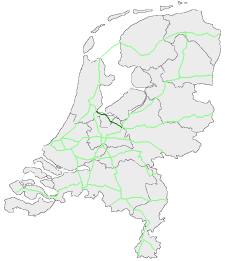
The international E-road network is a numbering system for roads in Europe developed by the United Nations Economic Commission for Europe (UNECE). The network is numbered from E1 up and its roads cross national borders. It also reaches Central Asian countries like Kyrgyzstan, since they are members of the UNECE.

Amersfoort is a city and municipality in the province of Utrecht, Netherlands and is situated at the eastern edge of the Randstad. As of 1 January 2019, the municipality had a population of 156,286, making it the second-largest of the province and fifteenth-largest of the country. Amersfoort is also one of the largest Dutch railway junctions with its three stations—Amersfoort Centraal, Schothorst and Vathorst—due to its location on two of the Netherlands' main east to west and north to south railway lines. The city was used during the 1928 Summer Olympics as a venue for the modern pentathlon events. Amersfoort marked its 750th anniversary as a city in 2009.

Baarn is a municipality and a town in the Netherlands, near Hilversum in the province of Utrecht.
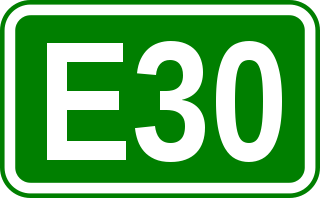
European route E30 is an A-Class European route from the port of Cork in the Republic of Ireland in the west to the Russian city of Omsk, near the border with Kazakhstan in the east. For much of the Russian stretch, it follows the Trans-Siberian Highway and, east of the Ural Mountains, with AH6 of the Asian Highway Network, which continues to Busan, South Korea. The total length is 6,530 km (4,060 mi)—3,300 km (2,100 mi) from Cork to Moscow, and 3,230 km (2,010 mi) from Moscow to Omsk. The naming is by the United Nations Economic Commission for Europe (UNECE).

Amsterdam Zuid is a railway station situated in the borough of Amsterdam-Zuid in Amsterdam, Netherlands. For a number of years, it was named Amsterdam Zuid WTC, in reference to the neighbouring World Trade Center Amsterdam. During 2006, in conjunction with the rapid development of the area surrounding the station, the station was enlarged and the reference to the WTC was formally dropped from the name.

European route E28 is a west-east intermediate road in the international E-road network. Beginning at the Bundesautobahn 10 in Germany, it runs west-east for a length of 1,230 km (760 mi) to Minsk, Belarus. The section between Kaliningrad and Minsk is part of the Pan-European Corridor IX.
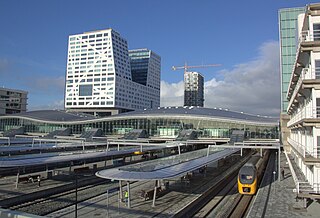
Utrecht Centraal, officially Station Utrecht Centraal, is the transit hub that integrates two bicycle parkings, two bus stations, two tram stops and the central railway station for the city of Utrecht in the province of Utrecht, Netherlands.

The Directorate-General for Public Works and Water Management, founded in 1798 as the Bureau voor den Waterstaat, is part of the Ministry of Infrastructure and Water Management of the Netherlands, the former Ministry of Transport, Public Works and Water Management. Its role is the practical execution of the public works and water management, including the construction and maintenance of waterways and roads, and flood protection and prevention. The agency was also involved in the construction of big railway projects such as the Betuweroute and the HSL-Zuid.

The A28 motorway is a motorway in the Netherlands. It is approximately 188 kilometers in length.

The A1 is a motorway in the Netherlands. The road connects the capital city of Amsterdam, near the interchange of Watergraafsmeer, with the German border, near Oldenzaal and Bad Bentheim, and the German Autobahn BAB 30. On its way, it crosses four provinces: North Holland, Utrecht, Gelderland and Overijssel.

The A2 motorway is a motorway in the Netherlands. It is one of the busiest highways in the Netherlands. The road connects the city of Amsterdam, near the Amstel interchange with the Belgian border, near Maastricht (NL) and Liège (B), and the Belgian A25 road.

Amersfoort Centraal is the main railway station in Amersfoort in Utrecht, Netherlands. The station was an important link between the western part of the Netherlands and the north and east of the country until December 2012 when the Hanzelijn opened.

The E 232 is a European B class road in the Netherlands, connecting the cities of Amersfoort and Groningen.

European route E 233 is a west—east European Class-B road part of the International E-road network, running from Hoogeveen in the Netherlands to Cloppenburg in Germany, passing by the Dutch city of Emmen and the German city of Meppen. The road runs concurrently with four other roads over its course, first with the Dutch A37 from its western terminus to the German border, then with the German B402 up to Haselünne, from there on it follows B213 up to northern Cloppenburg, and on the last 2 kilometres (1.2 mi) of the B213 concurrency it also runs concurrent with B72, which it then follows up to its eastern terminus at the A1, which is also part of E 37. The road has a total length of 132 kilometres (82 mi), of which 41 kilometres (25 mi) in the Netherlands and 91 kilometres (57 mi) in Germany.
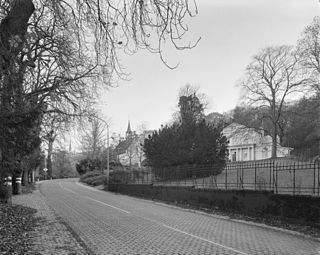
Rijksstraatweg or simply Straatweg was the term for paved roads of interregional significance in the Netherlands in the 19th and early 20th centuries. These roads were built by the national government, and formed the country's first centrally planned highway network. They received route numbers, eventually resulting in a nationwide network of 82 highways. It formed the basis for today's system of nationally controlled roads, the Netherlands' main highway grid.
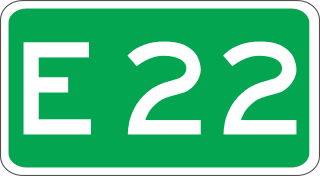
European route E 22 (E 22) is a west–east European route, running from Holyhead in the United Kingdom, through the Netherlands, Germany, Sweden and Latvia, to Ishim in Russia.

European route E 25 (E 25) is a north–south European route, running from Hook of Holland in the Netherlands to Palermo in Italy. In the Netherlands, the highway runs from its northern terminus in Hook of Holland south–eastward through Rotterdam, Utrecht, 's-Hertogenbosch, Eindhoven and Maastricht to the Belgian border, near Eijsden.

European route E 30 (E 30) is a west–east European route, running from Cork in Ireland to Omsk in Russia. In the Netherlands, the highway runs from Hook of Holland eastwards through The Hague, Utrecht, Amersfoort and Apeldoorn to the German border, near De Lutte.
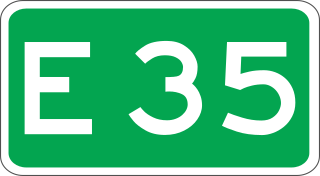
European route E 35 (E 35) is a north–south European route, running from Amsterdam in the Netherlands to Rome in Italy. In the Netherlands, the highway runs from its northern terminus in Amsterdam eastwards through Utrecht and Arnhem to the German border, near Zevenaar. The road runs concurrently with three other motorways over its entire length, starting on Rijksweg 10 (A10) around Amsterdam, then A2 from southern Amsterdam up to Utrecht, and the last part on A12 until it reaches the German border in the east.
